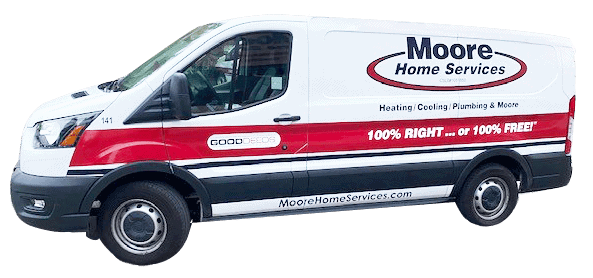How Does a Condensate Drain Pan Work?
Posted by Moore Home Services
HVAC Basics
Most people don’t know what a condensate drain pain is, but it’s an incredibly important part of your HVAC system. This small tray does a big job of protecting your home, and HVAC system, from water damage, mold growth, and even premature system failure.
Most of our Santa Rosa homeowners have no idea what this important part is, how it works, or why it’s there. For everything you wanted to know about a condensate drain pan, read on.
What is a Condensate Drain Pan?
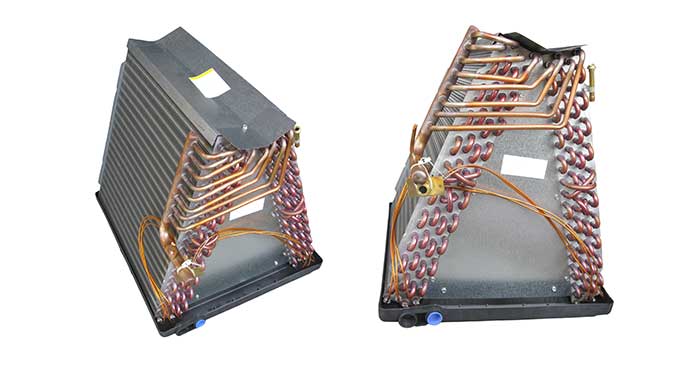
An air conditioner not only regulates the temperature in your home, but it also keeps your home from getting to humid. It pulls condensation from the air. Over the course of a day, an air conditioner can generate
between 5 and 20 gallons of condensation.
The condensate drain pan makes sure all that water has an exit strategy. The pan is located in the furnace. Directly under the evaporator coil.
As the evaporator cools your air, it fills with incredibly cold refrigerant. This sudden temperature drop pulls heat from your home’s air, but also creates a lot of condensation. Think of a glass of ice water on a hot day.
The cooling cycle generates so much condensation that it needs to be drained. It can’t evaporate quickly enough. As the drain pan fills with condensation, excess water goes into a drainage tube.
This tube ensures water is deposited outside the home and not into your home or your HVAC system.
Where is the condensate drain pan located?
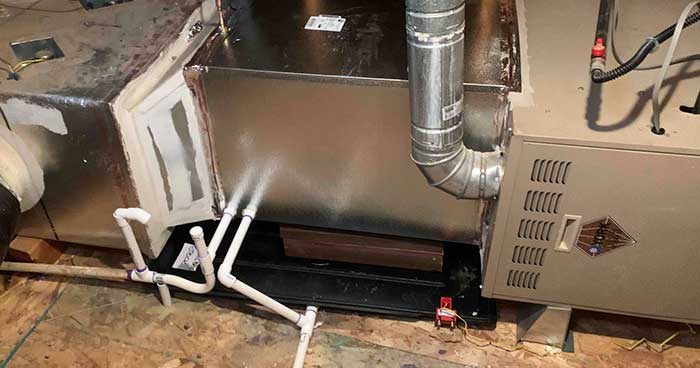
The condensate drain pan is directly underneath the evaporator coil. This is all located in the furnace. An Evaporator coil is usually found right before the air filter.
Indoor air is pulled in through supply vents, into the HVAC system, and then into the evaporator coil. The air is cooled, sent through the air filter and then is distributed to the rest of your home.
The exact location of the pan depends on how your AC is installed:
Vertical furnace installation or application
- These furnaces are in an upright position and commonly found in utility closets or garages. On these models, the evaporator coil is above the furnace and the drain pan is directly underneath the coil.
Horizontal furnace installation or application
- Oftentimes, a furnace in an attic will have a horizontal installation, meaning it is on its side. In this case, the evaporator coil sits beside the furnace and the condensate drain pan sits underneath. Horizontal furnaces will typically have a second drain pan.
Why does the horizontal application have a second drain pan?
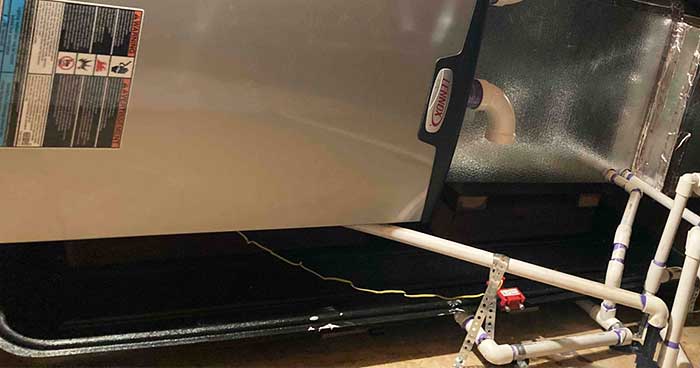
Upright furnaces don’t have a second drain pan because they never need to worry about water going anywhere but down.
Air flows from side to side in a horizontal furnace. So, if the furnace were to leak, water would drip from the entire system. This is why they are generally outfitted with a backup pan.
We mentioned earlier that an AC system can generate up to 20 gallons of condensation per day. That is enough water to do serious damage to your drywall, attic, insulation, and even the outside of your home. The second drain pan is a backup and also has a separate drip line.
Homeowners can tell when something is wrong because the drain line for this secondary pan is in a very obvious place. They can simply go outside and watch water flow from the top of their home.
When this happens, it’s time to schedule an appointment as soon as possible.
How does the condensate drain pan get damaged?
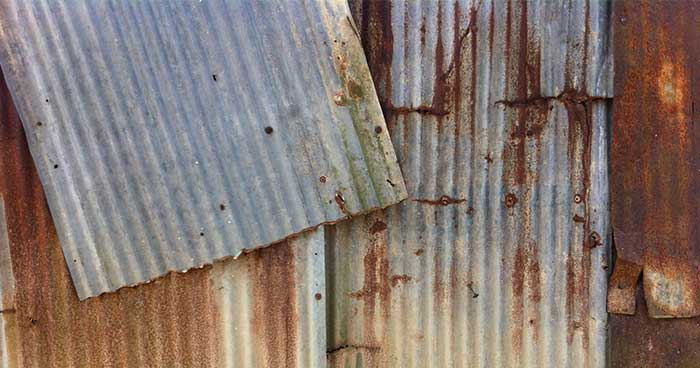
Unfortunately, the condensate drain pan can fail. Usually, it happens over time and with use.
The first condensate drain pans were made of metal. This poses a few problems. Firs is rust and the second is corrosion. Dripping water will rust the pan which will lead to cracks and holes.
Because of this, newer condensate drain pans are made from a strong plastic.
The plastic drain pans have a lifespan of 5-10 years depending on use and climate. They can be replaced, but to do so you would need to replace the entire evaporator coil. The two are connected.
This is a major reason it’s important to get regular tune-ups. A certified HVAC tech can tell you the state of your condensate drain pan and if it needs to be replaced.
What else damages the condensate drain pan?
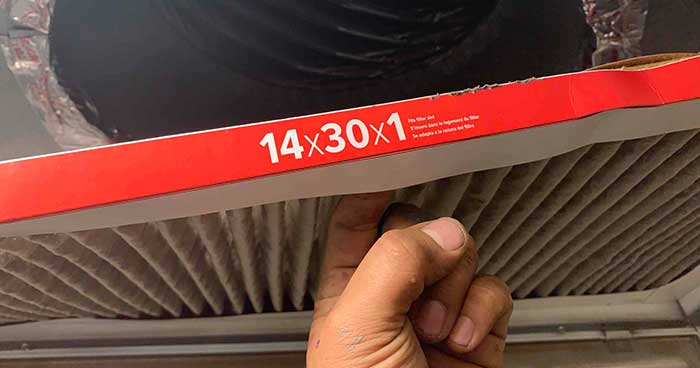
We already talked about how metal condensate drains pans can fail because of rust and corrosion. Unfortunately, even the plastic drain pans take a beating during the winter season because of warm air from the furnace.
When it’s cold out, the drain pan is washed with a burst of warm air during every heating cycle. The direct heat can pull any bit of moisture from the pan, which could lead to cracks and leaks.
Any cracks can compromise the condensate drain pan. Cracks lead to water leaks, which can lead to water pooling at the bottom of the evaporator coil and potentially other areas of your furnace.
The drain line in the pan can also get backed up. When this happens, water can’t drain and instead it flows all over the HVAC system itself.
This usually happens when your air filter is dirty. The air filter does two very important jobs. It keeps dust, dander, and other debris out of the HVAC system and out of the air you breathe.
A clogged filter can’t properly block the indoor air contaminates that could clog the waste line in your drain pan.
Also, the condensate drain pan is not made to hold a lot of water. It’s made to have water constantly cycling through, not standing still.
A clogged condensate line, a cracked condensate drain pan, or a soggy furnace can lead to many unwanted issues. This includes:
- Microbiological growth
- Safety hazards
- Low indoor air quality
- Internal buildup
- AC repairs
- Higher energy expenditure
- Smelly air
- Water damage to the home
Water gathering anywhere in your HVAC system can present a serious threat to the health and safety of your system and your home. If you suspect this, call an HVAC professional as soon as possible.
Care for Your Condensate Drain Pan with Moore Home Services
Moore Home Services is a Diamond Certified plumbing and HVAC company that proudly serves communities in Sonoma, Santa Rosa, and the North Bay Area.
Our techs are expertly trained and ready to handle any situation they may come across. To meet your HVAC specialist, dial the number at the top of the screen, or click here to book an appointment online.
 An air conditioner not only regulates the temperature in your home, but it also keeps your home from getting to humid. It pulls condensation from the air. Over the course of a day, an air conditioner can generate between 5 and 20 gallons of condensation.
The condensate drain pan makes sure all that water has an exit strategy. The pan is located in the furnace. Directly under the evaporator coil.
As the evaporator cools your air, it fills with incredibly cold refrigerant. This sudden temperature drop pulls heat from your home’s air, but also creates a lot of condensation. Think of a glass of ice water on a hot day.
The cooling cycle generates so much condensation that it needs to be drained. It can’t evaporate quickly enough. As the drain pan fills with condensation, excess water goes into a drainage tube.
This tube ensures water is deposited outside the home and not into your home or your HVAC system.
An air conditioner not only regulates the temperature in your home, but it also keeps your home from getting to humid. It pulls condensation from the air. Over the course of a day, an air conditioner can generate between 5 and 20 gallons of condensation.
The condensate drain pan makes sure all that water has an exit strategy. The pan is located in the furnace. Directly under the evaporator coil.
As the evaporator cools your air, it fills with incredibly cold refrigerant. This sudden temperature drop pulls heat from your home’s air, but also creates a lot of condensation. Think of a glass of ice water on a hot day.
The cooling cycle generates so much condensation that it needs to be drained. It can’t evaporate quickly enough. As the drain pan fills with condensation, excess water goes into a drainage tube.
This tube ensures water is deposited outside the home and not into your home or your HVAC system.
 The condensate drain pan is directly underneath the evaporator coil. This is all located in the furnace. An Evaporator coil is usually found right before the air filter.
Indoor air is pulled in through supply vents, into the HVAC system, and then into the evaporator coil. The air is cooled, sent through the air filter and then is distributed to the rest of your home.
The exact location of the pan depends on how your AC is installed:
Vertical furnace installation or application
The condensate drain pan is directly underneath the evaporator coil. This is all located in the furnace. An Evaporator coil is usually found right before the air filter.
Indoor air is pulled in through supply vents, into the HVAC system, and then into the evaporator coil. The air is cooled, sent through the air filter and then is distributed to the rest of your home.
The exact location of the pan depends on how your AC is installed:
Vertical furnace installation or application
 Upright furnaces don’t have a second drain pan because they never need to worry about water going anywhere but down.
Air flows from side to side in a horizontal furnace. So, if the furnace were to leak, water would drip from the entire system. This is why they are generally outfitted with a backup pan.
We mentioned earlier that an AC system can generate up to 20 gallons of condensation per day. That is enough water to do serious damage to your drywall, attic, insulation, and even the outside of your home. The second drain pan is a backup and also has a separate drip line.
Homeowners can tell when something is wrong because the drain line for this secondary pan is in a very obvious place. They can simply go outside and watch water flow from the top of their home.
When this happens, it’s time to schedule an appointment as soon as possible.
Upright furnaces don’t have a second drain pan because they never need to worry about water going anywhere but down.
Air flows from side to side in a horizontal furnace. So, if the furnace were to leak, water would drip from the entire system. This is why they are generally outfitted with a backup pan.
We mentioned earlier that an AC system can generate up to 20 gallons of condensation per day. That is enough water to do serious damage to your drywall, attic, insulation, and even the outside of your home. The second drain pan is a backup and also has a separate drip line.
Homeowners can tell when something is wrong because the drain line for this secondary pan is in a very obvious place. They can simply go outside and watch water flow from the top of their home.
When this happens, it’s time to schedule an appointment as soon as possible.
 Unfortunately, the condensate drain pan can fail. Usually, it happens over time and with use.
The first condensate drain pans were made of metal. This poses a few problems. Firs is rust and the second is corrosion. Dripping water will rust the pan which will lead to cracks and holes.
Because of this, newer condensate drain pans are made from a strong plastic.
The plastic drain pans have a lifespan of 5-10 years depending on use and climate. They can be replaced, but to do so you would need to replace the entire evaporator coil. The two are connected.
This is a major reason it’s important to get regular tune-ups. A certified HVAC tech can tell you the state of your condensate drain pan and if it needs to be replaced.
Unfortunately, the condensate drain pan can fail. Usually, it happens over time and with use.
The first condensate drain pans were made of metal. This poses a few problems. Firs is rust and the second is corrosion. Dripping water will rust the pan which will lead to cracks and holes.
Because of this, newer condensate drain pans are made from a strong plastic.
The plastic drain pans have a lifespan of 5-10 years depending on use and climate. They can be replaced, but to do so you would need to replace the entire evaporator coil. The two are connected.
This is a major reason it’s important to get regular tune-ups. A certified HVAC tech can tell you the state of your condensate drain pan and if it needs to be replaced.
 We already talked about how metal condensate drains pans can fail because of rust and corrosion. Unfortunately, even the plastic drain pans take a beating during the winter season because of warm air from the furnace.
When it’s cold out, the drain pan is washed with a burst of warm air during every heating cycle. The direct heat can pull any bit of moisture from the pan, which could lead to cracks and leaks.
Any cracks can compromise the condensate drain pan. Cracks lead to water leaks, which can lead to water pooling at the bottom of the evaporator coil and potentially other areas of your furnace.
The drain line in the pan can also get backed up. When this happens, water can’t drain and instead it flows all over the HVAC system itself.
This usually happens when your air filter is dirty. The air filter does two very important jobs. It keeps dust, dander, and other debris out of the HVAC system and out of the air you breathe.
A clogged filter can’t properly block the indoor air contaminates that could clog the waste line in your drain pan.
Also, the condensate drain pan is not made to hold a lot of water. It’s made to have water constantly cycling through, not standing still.
A clogged condensate line, a cracked condensate drain pan, or a soggy furnace can lead to many unwanted issues. This includes:
We already talked about how metal condensate drains pans can fail because of rust and corrosion. Unfortunately, even the plastic drain pans take a beating during the winter season because of warm air from the furnace.
When it’s cold out, the drain pan is washed with a burst of warm air during every heating cycle. The direct heat can pull any bit of moisture from the pan, which could lead to cracks and leaks.
Any cracks can compromise the condensate drain pan. Cracks lead to water leaks, which can lead to water pooling at the bottom of the evaporator coil and potentially other areas of your furnace.
The drain line in the pan can also get backed up. When this happens, water can’t drain and instead it flows all over the HVAC system itself.
This usually happens when your air filter is dirty. The air filter does two very important jobs. It keeps dust, dander, and other debris out of the HVAC system and out of the air you breathe.
A clogged filter can’t properly block the indoor air contaminates that could clog the waste line in your drain pan.
Also, the condensate drain pan is not made to hold a lot of water. It’s made to have water constantly cycling through, not standing still.
A clogged condensate line, a cracked condensate drain pan, or a soggy furnace can lead to many unwanted issues. This includes:

